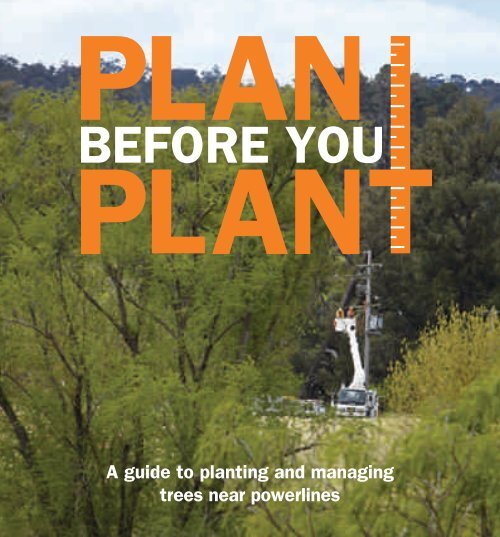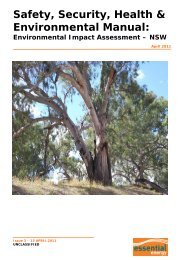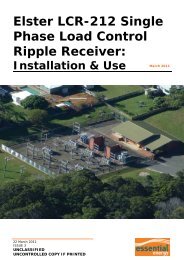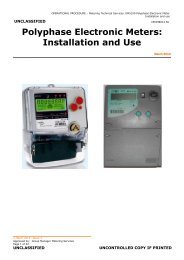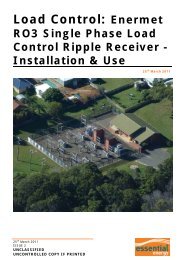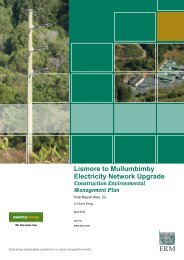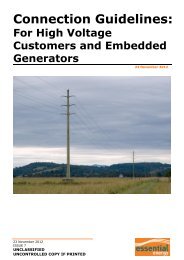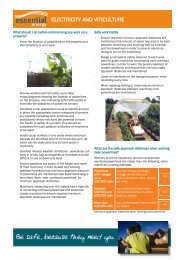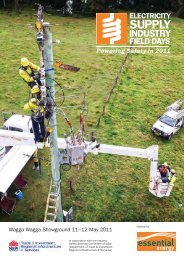To download our comprehensive Plan Before ... - Essential Energy
To download our comprehensive Plan Before ... - Essential Energy
To download our comprehensive Plan Before ... - Essential Energy
You also want an ePaper? Increase the reach of your titles
YUMPU automatically turns print PDFs into web optimized ePapers that Google loves.
A guide to planting and managing<br />
trees near powerlines
Vegetation management near powerlines<br />
The right trees in the right place provide shade, privacy, wildlife<br />
habitat and help prevent erosion.<br />
The wrong trees planted near powerlines can become a safety<br />
hazard to the local environment and property, and may impact<br />
the reliability of y<strong>our</strong> power supply.<br />
Vegetation must be managed near powerlines to maintain public<br />
safety. By working together with the communities we serve, we<br />
can achieve a sustainable outcome for everyone. In doing so we<br />
will minimise the risk of power supply interruptions caused by<br />
vegetation falling on, or coming into contact with, powerlines.<br />
Why vegetation management is important<br />
Continuous vegetation management:<br />
> Reduces the potential harm to people, damage to property<br />
or the local environment<br />
> Minimises tree-related power supply interruptions<br />
> Reduces the incidence of branches contacting powerlines<br />
and potentially causing bushfires.<br />
Our vegetation management program relies on a collaboration<br />
between councils, landowners or occupiers and the broader<br />
community to ensure all vegetation is kept a safe distance<br />
from powerlines.<br />
For safety’s sake
Our people are inspecting and responding to trees and other<br />
vegetation encroaching on electricity infrastructure every day.<br />
It’s a constant job and an essential part of <strong>our</strong> maintenance<br />
program. We know many problems can be avoided if we take<br />
action early and enc<strong>our</strong>age more appropriate vegetation to be<br />
planted near powerlines.<br />
Vegetation management benefits everyone<br />
Always plant a tree at least 15 metres away from<br />
powerlines or a distance equal to its mature height<br />
– whichever is greater.<br />
Make sure any vegetation is kept well clear<br />
of powerlines.<br />
Remember – tree trimming can be hazardous near<br />
overhead powerlines and should only be performed<br />
by qualified tree trimmers.<br />
<strong>To</strong> avoid the need for tree trimming we enc<strong>our</strong>age<br />
landowners to plant responsibly – <strong>Plan</strong> <strong>Before</strong> You <strong>Plan</strong>t.<br />
Use this guide as a s<strong>our</strong>ce of information to <strong>Plan</strong> <strong>Before</strong> You <strong>Plan</strong>t<br />
and determine what species are not appropriate to plant near<br />
powerlines and what guidelines you should follow when planting<br />
near powerlines.<br />
If you are unsure, contact y<strong>our</strong> regional Vegetation Operations<br />
Coordinator at <strong>Essential</strong> <strong>Energy</strong>. You will find their contact<br />
details in the back of this booklet.<br />
The ideal safety measure
Botanical Name<br />
Acacia species (large)<br />
Acer species<br />
Acmena species (large)<br />
Alnus species<br />
Araucaria species<br />
Bambusa species<br />
Banksia species (large)<br />
Betula species<br />
Brachychiton species<br />
Caesalpinia ferrea<br />
Casuarina species<br />
Cedrus species<br />
Celtis species<br />
Cinnamomum camphora<br />
Cupressus species<br />
Delonix regia<br />
Erythrina species<br />
Eucalyptus species<br />
Ficus species<br />
Fraxinus species<br />
Gleditsia species<br />
Grevillea robusta<br />
Hymenosporum flavum<br />
Jacaranda mimosifolia<br />
Ligustrum species<br />
Common Name<br />
Wattle<br />
Maples (not Japanese)<br />
Lilly Pilly or Bush Cherry<br />
Black and Evergreen Alder<br />
Bunya-Bunya, Hoop or Norfolk Island Pine<br />
Bamboo<br />
Banksia<br />
Birch<br />
Lace-Bark, Flame and Kurrajong<br />
Leopard tree<br />
She-Oak<br />
Cedar, also Fir and Spruce<br />
Nettle tree<br />
Camphor Laurel<br />
Cypress trees<br />
Poinciana or Flamboyant<br />
Coral tree<br />
Gum tree<br />
Fig tree<br />
Ash<br />
Honey Locust<br />
Silky Oak<br />
Native Frangipani<br />
Jacaranda<br />
Privet
Liquidamber species Liquid Amber<br />
Lophostemon confertus Brush Box<br />
Magnolia grandiflora Bull Bay Magnolia<br />
Melaleuca species (large) Paperbarks<br />
Melia azedarach<br />
White Cedar<br />
Palm species<br />
Palm<br />
Pinus species<br />
Pine<br />
Platanus species<br />
<strong>Plan</strong>e tree<br />
Populus species<br />
Poplar<br />
Quercus species<br />
Oak<br />
Salix species<br />
Willow<br />
Schinus species<br />
Peppercorn tree<br />
Stenocarpus sinuatus Queensland Firewheel tree<br />
Syncarpia glomulifera Turpentine<br />
Syzygium species<br />
Lilly Pilly or Bush Cherry<br />
Tamarix aphylla<br />
Athel Pine<br />
Tilia species<br />
Linden or Lime tree<br />
Tipuana tipu<br />
Racehorse tree<br />
Ulmus species<br />
Elm<br />
Zelkova serrata<br />
Japanese Elm<br />
Tall growing fruit and nut trees<br />
Please note: most trees are unsuitable for planting<br />
under or near powerlines.<br />
Unsuitable trees for planting near powerlines
<strong>Plan</strong>ting Guide<br />
<strong>Plan</strong>t a tree no closer to powerlines than 15 metres OR a distance<br />
equal to its mature height – whichever is greater.<br />
> Look up before you plant.<br />
> Consider how big the tree or vegetation will grow and what<br />
structures will be affected.<br />
> <strong>Plan</strong>t taller varieties further away from powerlines using the<br />
planting guide above.<br />
> Do not plant on the nature strip without local council approval.<br />
> Remember that access to powerlines is required for future<br />
maintenance and repairs.<br />
> Select plant species that are native to y<strong>our</strong> area.<br />
> Avoid plant species that could invade the surrounding environment.<br />
Consideration should also be given to underground powerlines to<br />
avoid roots damaging the underground network.<br />
> <strong>Plan</strong>t away from underground electricity pits, pillar boxes and<br />
padmount transformers to ensure electricity assets are accessible<br />
for inspection, maintenance or repair.<br />
> Consult a local nursery before planting to determine the height<br />
that particular tree species may grow in y<strong>our</strong> area.<br />
> Tall growing species including the trees shown in the tables<br />
(on previous page) are unsuitable under or near powerlines.<br />
20m<br />
20m<br />
15m minimum<br />
<strong>Plan</strong>ting guide
How does <strong>Essential</strong> <strong>Energy</strong> determine which trees<br />
should be trimmed?<br />
As part of <strong>our</strong> <strong>comprehensive</strong> network maintenance program,<br />
powerlines are regularly inspected to assess risk levels and ensure<br />
minimum safety clearance zones * between vegetation and powerlines.<br />
Trimming further than the minimum safety clearance zone is also<br />
performed so vegetation will not encroach on this zone before trees<br />
are trimmed again. The voltage of nearby powerlines, local bushfire<br />
classifications and a tree’s age, species and general health are also<br />
taken into consideration.<br />
Who is responsible for tree trimming?<br />
<strong>Essential</strong> <strong>Energy</strong> has programs in place to identify trees and other<br />
vegetation that could damage or interfere with the power supply or<br />
pose a bushfire or public safety risk. We also enc<strong>our</strong>age landowners<br />
or occupiers to alert us if they’re concerned that vegetation is getting<br />
close to powerlines on their property by calling 13 23 91.<br />
Responsibility for the trimming or removal of trees identified as a risk<br />
may depend upon whether they’re naturally propagated or if they’ve been<br />
planted and allowed to grow directly under or alongside powerlines. Y<strong>our</strong><br />
local Vegetation Operations Coordinator will discuss this with you.<br />
Please do not attempt to trim trees near powerlines<br />
Trimming vegetation near powerlines is extremely dangerous and should<br />
only be undertaken by qualified personnel. Ask <strong>Essential</strong> <strong>Energy</strong> for<br />
further advice.
Why is it important to use qualified vegetation<br />
contractors?<br />
<strong>Essential</strong> <strong>Energy</strong> promotes best practice environmental management<br />
and all work is consistent with the Australian Standard AS4373 –<br />
Pruning of Amenity Trees. All vegetation contractors are required to<br />
comply with Workplace Health and Safety Regulations, use the latest<br />
internationally approved techniques and be competent in:<br />
> arboriculture techniques<br />
> the safe use of tools and equipment<br />
> herbicide application and storage<br />
> working near powerlines.<br />
They must also be qualified and authorised to meet industry<br />
regulatory requirements.<br />
A list of qualified and authorised vegetation contractors can be obtained<br />
by phoning y<strong>our</strong> regional Vegetation Operations Coordinator or visiting<br />
essentialenergy.com.au/trees<br />
How are trees trimmed?<br />
Like most Australian power companies, <strong>Essential</strong> <strong>Energy</strong> uses the<br />
standard arboriculture practice of directional pruning to ensure trees<br />
remain healthy and clear of powerlines. Directional pruning doesn’t<br />
interfere with a tree’s natural defence system and is well supported by<br />
years of research. Every effort is made to retain the visual appeal of<br />
trees, especially with significant or heritage trees, however, public<br />
safety and power supply reliability must be <strong>our</strong> top priority. In the<br />
event trees encroaching on powerlines pose a safety hazard to the<br />
community and a threat to the reliable supply of electricity, it may be<br />
necessary to remove the tree.<br />
*In NSW – the minimum accepted distance between vegetation and overhead powerlines, designed<br />
to accommodate safety clearances as well as regrowth, has been defined by the Industry Safety<br />
Steering Committee (ISSC) Guidelines ISSC 3 Guideline for Managing Vegetation Near Powerlines.<br />
Trimming trees
Tweed Heads<br />
Goondiwindi<br />
Inglewood<br />
Kyogle<br />
Murwillumbah<br />
Ewingsdale<br />
Texas<br />
Bonalbo<br />
Lismore<br />
Ballina<br />
Tenterfield<br />
Casino<br />
Woodburn<br />
B<strong>our</strong>ke<br />
Brewarrina<br />
Walgett<br />
Moree<br />
Narrabri<br />
Bingara<br />
Warialda<br />
Inverell<br />
Barraba<br />
Glen Innes<br />
Guyra<br />
Dorrigo<br />
Maclean<br />
Grafton<br />
NORTH<br />
COAST<br />
Coffs Harb<strong>our</strong><br />
NORTHERN<br />
Armidale<br />
Nambucca Heads<br />
FAR WEST<br />
Wilcannia<br />
Cobar<br />
Nyngan<br />
Coonamble<br />
Gunnedah<br />
Coonabarabran<br />
Tamworth<br />
Quirindi<br />
Walcha<br />
Kempsey<br />
Port Macquarie<br />
Broken Hill<br />
Warren<br />
Gilgandra<br />
Coolah<br />
Dunedoo<br />
Taree<br />
Gloucester<br />
Menindee<br />
<strong>To</strong>ttenham<br />
Narromine<br />
Dubbo<br />
Wellington<br />
Gulgong<br />
Mudgee<br />
Forster<br />
Bulahdelah<br />
Dungog<br />
Stroud<br />
Peak Hill<br />
Trundle<br />
Wentworth<br />
Buronga<br />
Balranald<br />
Moulamein<br />
<strong>To</strong>oleybuc<br />
Barham<br />
Condobolin<br />
Parkes<br />
Lake Cargelligo<br />
Forbes<br />
Hillston<br />
SOUTHERN<br />
Griffith<br />
Blayney<br />
Oberon<br />
Grenfell<br />
West Wyalong<br />
Cowra<br />
Young<br />
Temora<br />
Leeton<br />
Boorowa<br />
Hay<br />
Darlington Point<br />
Harden<br />
Cootamundra<br />
Narrandera<br />
Yass<br />
Coolamon<br />
Wagga Wagga<br />
Gundagai<br />
Junee<br />
Canowindra<br />
Molong<br />
Orange<br />
Bathurst<br />
Lockhart<br />
Queanbeyan<br />
Tumut<br />
Deniliquin Jerilderie<br />
Braidwood<br />
Berrigan<br />
Culcairn<br />
Batemans Bay<br />
Tumbarumba<br />
Moruya<br />
Corowa<br />
SOUTH EASTERN<br />
Moama<br />
Albury<br />
Cooma<br />
Jindabyne<br />
Crookwell<br />
Goulburn<br />
Vegetation Coordinator Regions<br />
Bombala<br />
Bega<br />
For assistance or clarification about planting trees and shrubs near<br />
powerlines, please contact y<strong>our</strong> regional Vegetation Operations<br />
Coordinator at <strong>Essential</strong> <strong>Energy</strong>.<br />
Far West<br />
Adrian Baird<br />
03 5025 4815<br />
adrian.baird@essentialenergy.com.au<br />
Northern/Far West<br />
Mark Daley<br />
02 6883 4525<br />
mark.daley@essentialenergy.com.au<br />
Southern/South Eastern<br />
Leo Driscoll<br />
02 6933 5863<br />
leo.driscoll@essentialenergy.com.au<br />
South Eastern<br />
Callum <strong>To</strong>wn<br />
02 6214 9803<br />
callum.town@essentialenergy.com.au<br />
Far North Coast<br />
Jason Whitelock<br />
02 6681 9149<br />
jason.whitelock@essentialenergy.com.au<br />
North Coast<br />
Clint Hansell<br />
02 6589 8647<br />
clint.hansell@essentialenergy.com.au<br />
Contact y<strong>our</strong> regional expert


